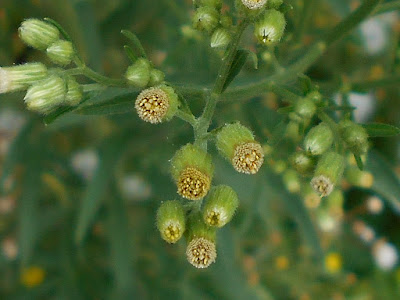Every year, towards the end of summer, people are surprised to see large orb webs appear in their gardens, with correspondingly large specimens of the Garden Cross Spider, Araneus diadematus, in occupation. Of course they have been there for several months but are relatively inconspicuous when at an immature stage.
 |
A Garden Cross Spider wraps up a greenbottle. Northampton General
Hospital grounds. 24 August, 2017
|
Just as I was passing a tangle of bindweed a greenbottle fly blundered into a web; a large female promptly dashed out and began to swathe the victim in silk. The spider looked quite plump and may have been gravid; she will lay her eggs in a silken cocoon and then die within a few weeks.
For some weeks I have been observing a plant of Deadly Nightshade, Atropa belladonna, as it produced its flower buds, bloomed and developed green fruits. Today I made my pilgrimage expecting to find ripe, purple fruits; alas, it had been cut to the ground and all the top growth was dead. The species has occupied the site for many decades and I am confident it will be back.
 |
Traveller's Joy, aka Old Man's Beard. Northampton General Hospital.
24 August, 2017
|
Many of the shrubs in otherwise tidy borders have become festooned with Traveller's Joy, Clematis vitalba. The plants are now in flower but have also now produced their white, feathery achenes, thus justifying the plant's alternative name of Old Man's Beard
 |
The same species in flower scrambling over a Cherry Laurel shrub.
Northampton General Hospital. 24 August, 2017
|
One or two flower beds are difficult to reach and specimens of Canadian Fleabane, Conyza canadensis, have taken advantage of the neglect to send up their tall panicles of flowers. They would not be planted deliberately as their flowers are very undistinguished.
 |
The tall spires of Canadian Fleabane in a neglected border.
Northampton General Hospital. 24 August, 2017
|
Although it is a native of North America it has been known in Britain from the 17th century but seems to have flourished on ruins and waste ground following air raids in World War Two. Its seeds are borne on 'parachutes' and are quick to colonise any open, sunny spaces.
 |
The flowers of Canadian Fleabane rarely feature in floral bouquets!
|
I'll be back again at the hospital soon so watch for further exciting developments!
(I have just brought to mind the words of my maternal grandmother. Hailing from Earls Barton she had a strong Northamptonshire accent so that words like 'cross' would be pronounced as crorse; similarly a hospital was a horspital. Sometimes it sounded alarmingly like 'horse piddle'. 'Air Ida's bin under the doctor at the horse piddle,' she would tell a startled audience.)
No comments:
Post a Comment